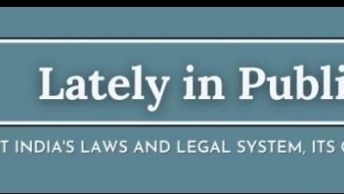Jayanth Krishnan has a new piece on SSRN which makes an interesting argument about public interest lawyering in India. In his words,
“The conventional assumption is that the decision to use constitutional litigation comes from the lawyers themselves. After all, the lawyers are the experts who are skilled in this rhetorical practice and thus are best able to determine how and when to employ this strategy. But by focusing on three different grassroots movements, in a different constitutionally-based and democratic society, India, I show how grassroots-leaders are actively involved in assisting their lawyers specifically recast the pressing concerns of everyday individuals into constitutionally recognizable claims. As I explain, the United States and India share a number of important legal and constitutional similarities that makes such a comparative investigation useful. Yet many might think that because issues of caste and other socioeconomic and political cleavages remain starkly present in India, such “bottom-up” pressure would be rather unlikely. But that such pressure indeed is occurring in the Indian case, as my findings and ultimate conclusion suggest, offers those who study cause lawyering and constitutional litigation in the American context an opportunity to reexamine the interaction between those at the grassroots and the lawyers who work on their behalf.”
Krishnan’s piece does a great job of locating the Public Interest Litigation (PIL) experience in India within the larger cause-lawyering discourse, and is a fine example of solid comparative constitutional law scholarship. I do have some doubts about whether Krishnan’s description of the PIL movement is applicable to the overall situation in respect of PIL lawyering beyond (and in some cases within) the specific areas he focuses on. My own sense is that the overall PIL movement tends to be lawyer-dominated, and litigation strategy and planning is affected more by the lawyers’ own sense of what the client needs. Effective consultation with clients, and genuine efforts to ensure that their ‘voice’ is reflected through the litigation is not as much of a priority as Krishnan’s portrayal suggests. To be fair to Krishnan, he does anticipate this criticism and suggests that this should be investigated by conducting further research on the processes by which PILs are initiated and pursued. Krishnan’s piece is an important and stimulating contribution to the dwindling scholarship on PIL in India.
If you do decide to check out Krishnan’s piece on SSRN, also check the relatively new section on India Law, which features pieces on a broad range of topics. As of now, the collection is quite small, but, given the growing interest in Indian legal issues, is sure to grow in times to come.






